Common menu bar links
Archived Content
Information identified as archived is provided for reference, research or recordkeeping purposes. It is not subject to the Government of Canada Web Standards and has not been altered or updated since it was archived. Please "contact us" to request a format other than those available.
Back to school – September 2008
Elementary/secondary enrolment trends, 1999/2000 to 2005/2006
Kids' sports participation has declined in recent years
The prevalence of disabilities among children increased between 2001 and 2006
Household spending on education
Canadians on the move
Increase in the proportion of Aboriginal people with a university degree
Immigrants account for a large proportion of doctorate and master's degree holders
Enrolment in Canadian universities increased for the fifth consecutive year during the 2005/2006 academic year
By the age of 24 to 26, close to eight out of ten young adults had attended a postsecondary education institution
Women leave home at a younger age than men
The age of leaving home and home ownership
Managers earning more, but no wage growth for retail, clerical and blue-collar workers
Elementary/secondary enrolment trends, 1999/2000 to 2005/2006
Enrolments in Canadian elementary and secondary public schools declined between school years 1999/2000 and 2005/2006. Just over 5.2 million children were enrolled in 2005/2006, down 3% from 1999/2000. The only province to report an increase was Alberta, where enrolment increased 1% to 552,000.
The largest decline in enrolment occurred in Newfoundland and Labrador, where the number of students has fallen 18.4% since 1999/2000. This was consistent with population estimates that show the province's school-age population fell 17.7% during the same period. Elsewhere, declines ranged from 10.1% in Nova Scotia to 0.6% in Ontario.
Chart 1
Percent change in enrolments (headcounts) between 1999/2000 to 2005/2006, Canada, provinces and territories

Source: Statistics Canada. Blouin, Patric. 2008. Summary Public School Indicators for the Provinces and Territories, 1999/2000 to 2005/2006. Culture, Tourism and the Centre for Education Statistics - Research Papers number 67. Statistics Canada Catalogue number 81-595-MIE2008067.
Kids' sports participation has declined in recent years
In 2005, 51% of children aged 5 to 14 regularly took part in organized sports during the previous 12 months. Boys' participation in organized sports has declined in all age groups, while girls' participation depends on their age. In 2005, 5 to 10 year-old girls played organized sports at about the same rate as in 1992, but girls aged 11 to 14 were less likely to play sports than they did in 1992. However, the decline for girls was less sharp than for boys the same age.
Chart 2
Kids' sports participation has declined in recent years

Source: Statistics Canada. Warren Clark. 2003. "Kids' Sports." Canadian Social Trends. Number 85 - 2008001, Statistics Canada Catalogue number 11-008-XWE.
Sports participation is most prevalent among children from high-income households, at 68%, and lowest among children from lower-income households, at 44%. The participation gap between boys and girls narrows as household income rises, suggesting that girls from lower-income families are particularly disadvantaged when it comes to involvement in sports.
The prevalence of disabilities among children increased between 2001 and 2006
In 2006, 4.6% of Canadian children between the ages of 5 and 14 had one or more disabilities, up from 2001. The number of boys reported to have a disability was significantly higher than for girls.
Chart 3
Number of children aged 5 to 14 with disabilities, by sex and age group, Canada, 2001 and 2006
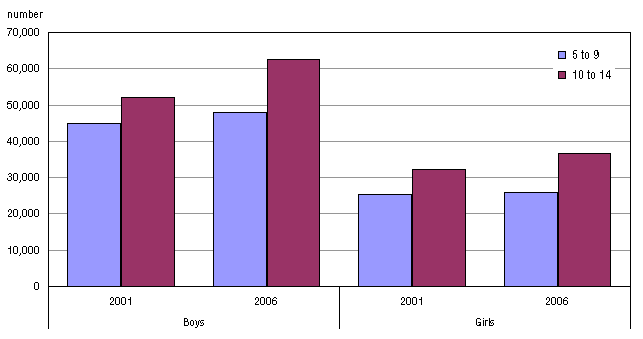
Source: Statistics Canada. 2008. Participation and Activity Limitation Survey of 2006: A Profile of Education for Children with Disabilities in Canada. The 2006 Participation and Activity Limitation Survey: Disability in Canada number 4. Statistics Canada Catalogue number 89-628-XWE.
More than 40% of Canadian children with disabilities aged 5 to 14 received some form of special education during the 2005/2006 school year, roughly the same proportion as reported in 2000/2001. The vast majority of parents reported learning disabilities as the most common condition requiring special education for their children.
Parents of children with psychological, emotional or behavioural conditions were more likely than parents of children with other types of disbilities to report difficulty obtaining special education for their child.
For most parents, difficulties were related to a lack of available special education services and staff. More than one half reported problems having their child tested for special education services.
Household spending on education
In 2006, 43% of Canadian households incurred education expenses for such items as textbooks, school supplies and tuition costs, spending an average of $ 2,703.
Spending on school supplies was most common, with 29% of households reporting such expenditures. Postsecondary tuition fees accounted for the largest expenditures – among the 19% of households that incurred such costs, average spending amounted to $ 3,821 in 2006, ranging between $ 1,555 in Quebec and $ 5,511 in Nova Scotia.
Chart 4
Percentage of households incurring education expenditures, Canada, 2006
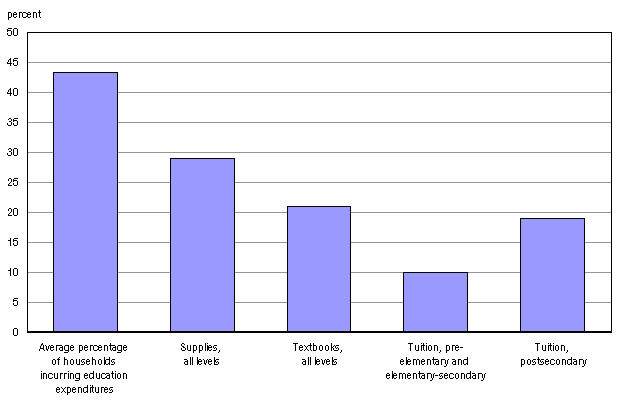
Chart 5
Average expenditure per household on education, Canada, 2006
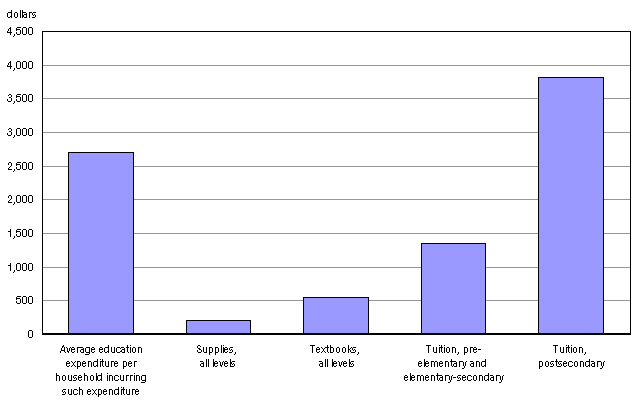
Source: Statistics Canada. Education Indicators in Canada: Report of the Pan-Canadian Education Indicators Program 2007. Statistics Canada Catalogue no. 81-582-XIE no. 5. Updates: Figures and tables, June 16, 2008.
Canadians on the move
In 2006, about 3% of adults aged between 25 and 64, nearly 550,000 people, did not live in the same province or territory as they had five years earlier. Overall, these people had a higher level of education than the general population.
Alberta and British Columbia gained the most postsecondary graduates of all the provinces. Overall, Alberta had a net increase of 28,000 postsecondary graduates and British Columbia, a net increase of nearly 15,800. Nearly 7,500 of this net increase of postsecondary graduates who moved to Alberta came from Saskatchewan, followed close behind by 7,200 graduates from Ontario.
Ontario incurred a net outflow of 17,900 people aged between 25 and 64, of whom 10,200 were postsecondary graduates. This was the biggest outflow of all provinces and territories and it was primarily due to trades and college graduates. In fact, nearly 5,600 college graduates and 3,900 trades graduates who lived in Ontario in 2001 lived in another province or territory in 2006. Over 8,400 of this net interprovincial out-migration of postsecondary graduates was to British Columbia, followed by 7,200 postsecondary graduates moving to Alberta. The outward migration was offset by a net increase from some provinces – notably, there was a net increase of 3,300 postsecondary graduates moving to Ontario from Quebec.
Source: Statistics Canada. 2008. Educational Portrait of Canada, 2006 Census. Statistics Canada Catalogue no. 97-560-X.
Increase in the proportion of Aboriginal people with a university degree
According to the 2006 Census, one in three (34%) Aboriginal persons aged 25 to 64 had not completed high school and 21% had a high school diploma as their highest educational qualification. This compares to a national average of 15% without high school completion and 24% with high school completion as their highest level of educational attainment.
At the same time, an estimated 44% of the Aboriginal population were postsecondary graduates in 2006. An estimated 14% had trade credentials and 19% had a college diploma. In comparison, the national average of adults with a trade certification as their highest level of educational attainment was 12% and the national average for college completion was 20%.
However, Aboriginal people were still much less likely to have a university degree (8%) than the non-Aboriginal population (23%).
Source: Statistics Canada. 2008. Educational Portrait of Canada, 2006 Census. Statistics Canada Catalogue no. 97-560-X.
Immigrants account for a large proportion of doctorate and master's degree holders
In 2006, one third of persons between the ages of 25 and 64 born outside Canada had a university degree. Of the 'recent' immigrants – those who immigrated between 2001 and 2006, 51%, had a university degree. This was more than twice the proportion of degree holders among the Canadian-born population (20%) and much higher than the proportion of 28% among immigrants who arrived in Canada before 2001.
In contrast, only 11% of recent immigrants in this age range had a college diploma and only 5% had a trades certificate. These proportions were considerably less than the 14% of the Canadian-born population who had a trades certificate and the 22% with a college diploma.
Although 23% of Canadians aged between 25 and 64 were born outside Canada, they accounted for nearly one-half (49%) of the doctorate holders in Canada and for 40% of adults with a master's degree.
Source: Statistics Canada. 2008. Educational Portrait of Canada, 2006 Census. Statistics Canada Catalogue number 7-560-X.
Enrolment in Canadian universities increased for the fifth consecutive year during the 2005/2006 academic year
According to the most recent Statistics Canada data, an estimated 1,047,700 students registered for classes in 2005/2006, up 3.0% from 2004/2005 when enrolment surpassed the 1-million mark for the first time, thanks to Ontario's double cohort, among other factors.
As in previous years, most of the growth in 2005/2006 was fuelled by students aged 18 to 24. These young adults represented 64% of total enrolment, compared to 59% a decade earlier.
Women still vastly outnumbered men in Canadian universities. Female students accounted for 58% of all registrations, a proportion that has remained steady since 2001. This was up from 56% in 1995/1996 and 51% in 1985/1986.
Chart 6
University enrolment, 1999/2000 and 2005/2006
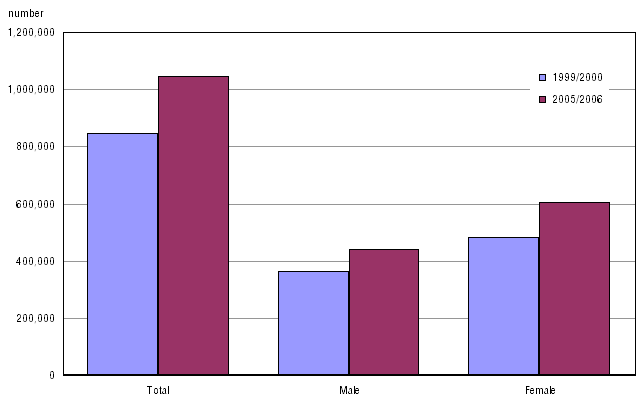
Source: See The Daily, February 7, 2008.
By the age of 24 to 26, close to eight out of ten young adults had attended a postsecondary education institution
In December 2005, close to eight out of every ten young people whose major transitions in life were tracked over a six-year period (since 1999) had gone to a postsecondary institution, such as a college, university or other type of institution. This represents a large increase in the postsecondary education participation rate compared to 1999, when these young people were between the ages of 18 and 20.
This growth in postsecondary participation during the six-year period was mainly attributable to gains in university attendance. As of December 2005, 40% of these young people were attending university, double the rate of 21% six years earlier. During the same period, participation rates for both college/CEGEP and other postsecondary institutions increased by only 3 percentage points from 23% to 26%.
More women than men had participated in postsecondary education and their participation rate was higher for both university and college. This male/female gap was observed in December 1999 and did not change over time.
Chart 7
Cumulative rate of postsecondary participation
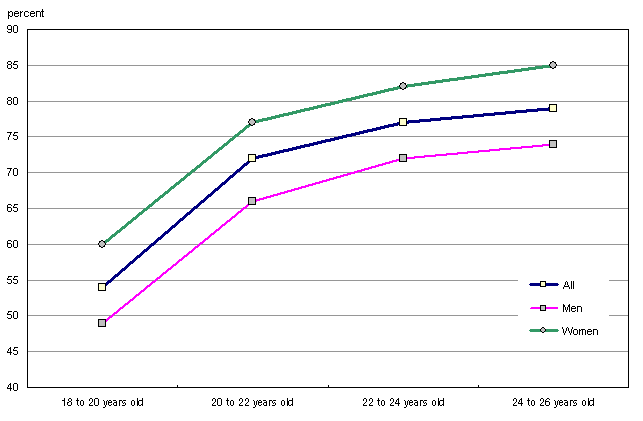
Source: Statistics Canada. Shaienks, Danielle et Tomasz Gluszynski. 2007. Participation in Postsecondary Education : Graduates, Continuers and Drop Outs, Results from YITS Cycle 4. Culture, Tourism and the Centre for Education Statistics Research Papers series, number 059. Statistics Canada Catalogue number 81-595-MIE2007059.
See The Daily, November 20, 2007.
Women leave home at a younger age than men
For many parents, seeing their adult children leave home is viewed as an indicator of successful transition to adulthood. However, it is taking longer to reach that stage. In 2001, for example, 60% of men and 73% of women aged 25 were no longer living with their parents, compared to 78% of men and 89% of women aged 25 in 1971. Lving at home while attending school can make it easier and less expensive for young people to complete their education and obtain employment.
In each generation, young women tend to leave home sooner than men.
Chart 8
Young adults left home at an older age in 2001 than in 1971
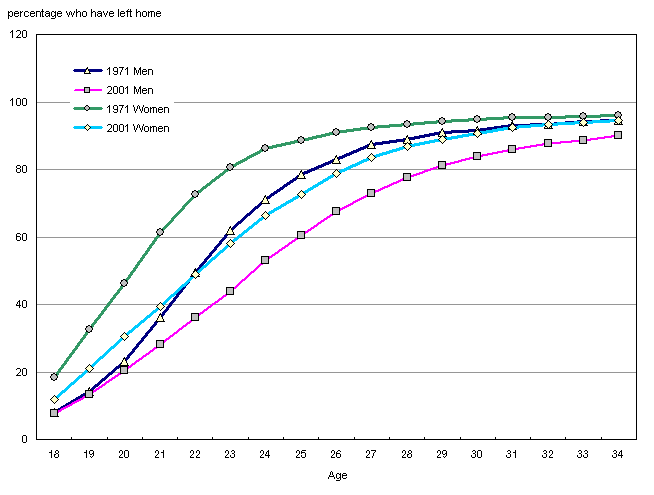
Source: Statistics Canada. Warren Clark. 2007. "Delayed transitions of young adults." Canadian Social Trends. Winter 2007, number 84. Statistics Canada Catalogue number 11-008-XWE.
See The Daily, September 18, 2007.
The age of leaving home and home ownership
The likelihood of becoming a homeowner increases in relation to the age at which the person left home, but only to a certain point. In fact, for those who left home after the age of 25, the likelihood of becoming a homeowner in their 30s decreases. The two groups that stand out most clearly, having the lowest rate of home ownership in their 30s, are those who left the family home very early (at age 16 or 17) and those who left later (at age 28 to 30).
Chart 9
The percentage of people who own their homes increases with age at departure from the parental home until about age 25
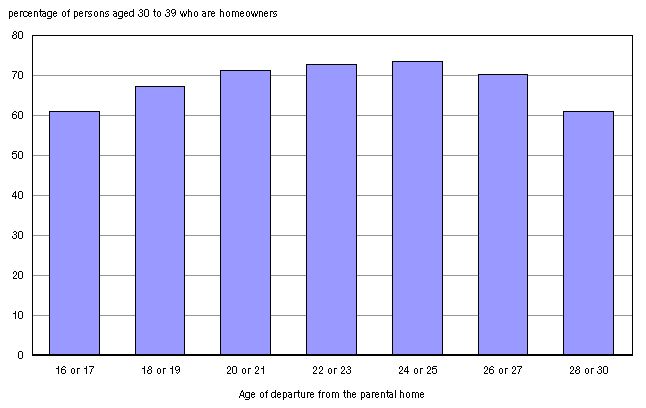
Source: Statistics Canada. Martin Turcotte. 2007. "Staying at home longer to become homeowners?" Canadian Social Trends. 2007006. number 84. Statistics Canada Catalogue number 11-008-XWE.
See The Daily December 11, 2007
Managers earning more, but no wage growth for retail, clerical and blue-collar workers
Hourly earnings of managers and professionals employed in business, finance and computer and information systems increased faster than those of any other occupational groups during the past 10 years. On the other hand, blue-collar workers in manufacturing, clerical employees and salespeople in retail trade saw virtually no growth in earnings.
Between 1997/1998 and 2006/2007, the average hourly earnings of managers employed in the private sector grew a solid 20%. This was four times the average rate of 5% among other private-sector employees.
Hourly earnings of specialist managers — those involved in fields such as engineering, science, information systems, sales and marketing — increased by 23% on average. Those of other managers and of professionals employed in business and finance increased 18%.
In contrast, clerical workers and manufacturing employees involved in blue-collar work or supervision tasks saw virtually no wage growth. Nor did cashiers, retail salespersons or sales clerks. Wages stagnated for these workers, who represented 26% of private-sector employment in 2006/2007.
Chart 10
Earnings in the private sector increased more for managers than other employees in all industries
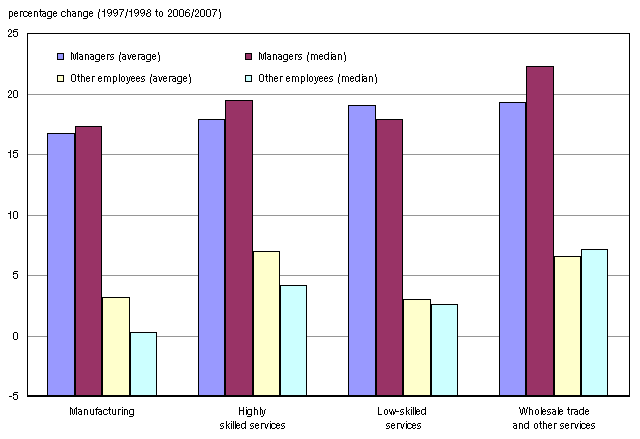
Source: Statistics Canada. Ren Morissette. 2008. "Earnings in the last decade." Perspectives on Labour and Income. February 2008. Volume 9, Number 2. Statistics Canada Catalogue number 75-001-X.

